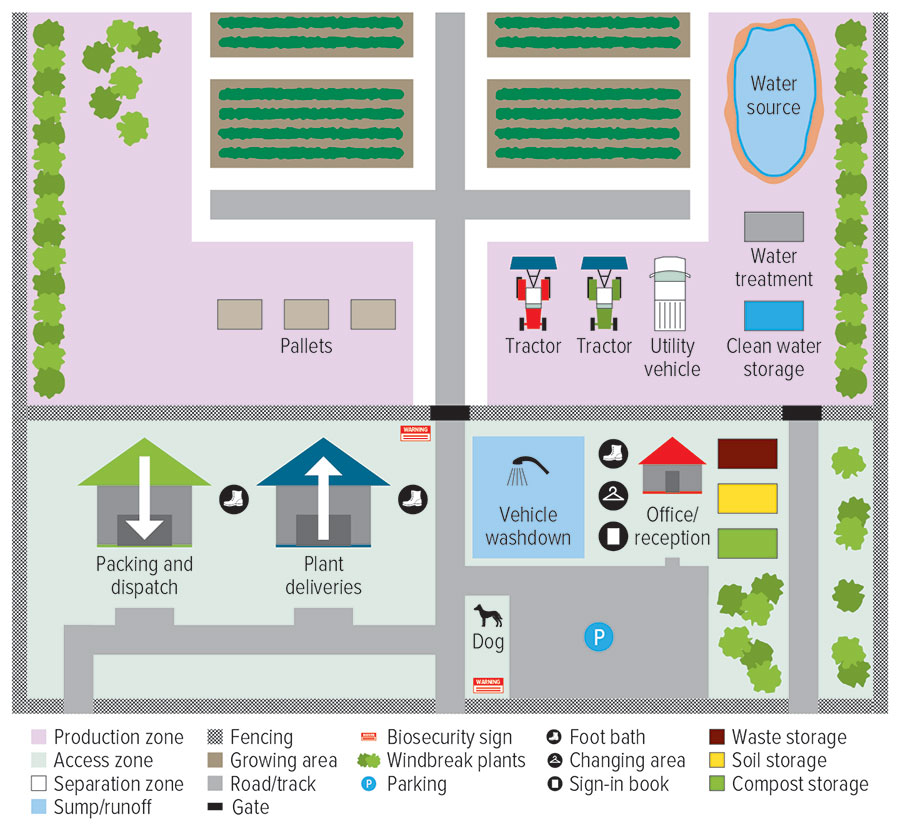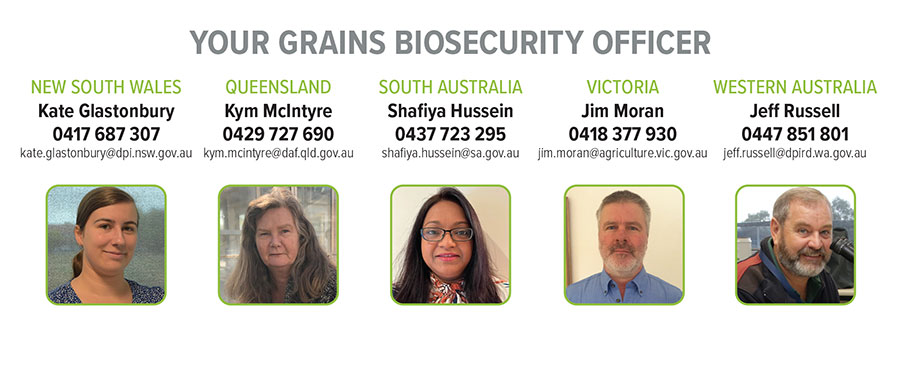Annually, more than $5 billion dollars is spent by Australian grain growers on controlling weeds, plant diseases and invertebrate pests. Implementing good farm biosecurity practices is a proven way to take control and reduce these costs.
Managing the movement of people, vehicles and machinery on the farm is one of the most effective ways to reduce the spread of pests and diseases.
People can carry weeds, pests and diseases on to and around your property on vehicles, equipment or clothing without realising it.
Restricting movement and adopting good hygiene practices, such as ensuring cleanliness of people and vehicles, are core practices to reduce the spread. However, it is not practical or possible to stop all vehicles or people from coming on to the farm, and clean-downs can be costly and time-consuming.
This is where property zoning as part of a farm biosecurity plan can help to reduce the spread of pests and maintain efficient farm operations.

Farm zones: example of best places to put biosecurity features such as signs, parking and washdown areas. Source: Farm zone map was created with help from AUSVEG
Property zoning is where you divide up your farm based on the level of biosecurity activity required to minimise the possibility of pests and diseases entering and establishing on your property. It is a powerful tool to protect your property from weeds, pests and diseases entering from another property via people, vehicles, machinery, fodder, livestock and wildlife.
In most cases, there will be three distinct zones to a farm:
- Zone one, the access zone;
- Zone two, the separation zone; and
- Zone three, thefarming (production) zone.
Each zone will have a different level of access and set of hygiene protocols. These are based on the level of risk that access could result in pest introductions and the ability to undertake risk reduction activities within the zone. Every farm is different, so it’s useful to start planning your biosecurity farm zones with a map of your property.
Access zone
The access zone is considered low-risk and includes the home residence and often the sheds or office if there is no contact with crops or produce.
Visitors, staff and deliveries can come and go, with no need to clean their vehicles because they are parked in designated areas near the farm entrance, office or house. Everything arriving here must be considered ‘dirty’ and unable to proceed to another zone without biosecurity and hygiene activities.
Separation zone
Zone two, the separation zone, often includes the area around sheds, silos or other grain storages where trucks pick up crop products or livestock, food, fertiliser or fuel deliveries. The major roads on the property might also be included in the separation zone as they provide access to different areas on-farm and might need to be used by emergency vehicles.
It is often a good idea to have a clean-down facility located in zone two for vehicles, machinery and equipment that need to access the productive areas (zone three).
There could be significant vehicle and people movement in this zone, so it is important to consider ways to reduce the risk of a new pest establishing. This can be achieved by ensuring that the area is well gravelled and kept clean of weeds. It should also be inspected regularly for new pests and weeds so they can then be controlled before they establish on the farm.
 Vehicle tyres and chassis are important areas to focus on when inspecting or cleaning down a vehicle. Source: QDAF
Vehicle tyres and chassis are important areas to focus on when inspecting or cleaning down a vehicle. Source: QDAF
Production zone
Zone three is the all-important farming (production) zone and is the most important area to protect. Stricter hygiene protocols are important for these parts of the property.
Where possible, access to zone three is restricted to designated vehicles and farming equipment. Prior to entry to this zone, equipment from outside the property should be inspected and cleaned of any dirt, plant matter and animal faeces that could harbour all manner of biosecurity threats. Important places to inspect include the tyres, radiator grille and around the chassis. If not clean, they should be directed to a clean-down facility before proceeding further.
It is also a good idea to interview anybody tasked with taking themselves and their machinery or vehicles into your production zone for essential work. Ask them about the previous properties visited, the pest and disease burdens, their efforts to clean down prior to arriving at your property and what assurances they can give that this was done. Alternatively, you can provide them with a vehicle to access the property.
However, it is not just about the vehicles and equipment – the visitors themselves could also be a pathway for weeds, pests and diseases to enter the farm. International visitors or people recently returned from overseas must not be wearing shoes or clothing (including hats or caps) that were recently worn overseas unless they have been carefully cleaned and disinfected.
Biosecurity plan
Once the zoning of the farm has been determined, it is important to have a plan for telling people about your requirements. Biosecurity gate signs provide an immediate signal to all visitors, contractors, workers and family that you have biosecurity and hygiene protocols in place and want them observed.
It will of course have to be followed up by advice on what the requirements are for each zone, which might also be communicated by further signs at checkpoints, training programs and routine compliance checks.
You probably already do this in an informal way, but it is a simple matter to make it a more formal system to protect your livelihood.
So, sign up now to signal your commitment to biosecurity zoning with a biosecurity gate sign. It is a small step towards the bigger goal of preventing the spread of pests, weeds and diseases on your property and protecting your livelihood.
New or replacement biosecurity gate signs are available free from the grains biosecurity officer in your state. They are supplied through grain grower levies, so you have already paid for them.

More information: Jim Moran, jim.moran@agriculture.vic.gov.au
See more about property zoning at farmbiosecurity.com.au

























































